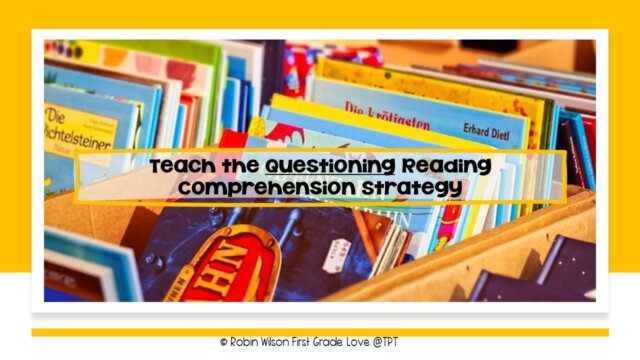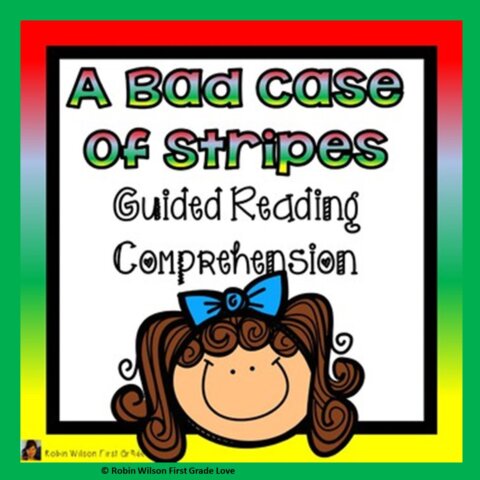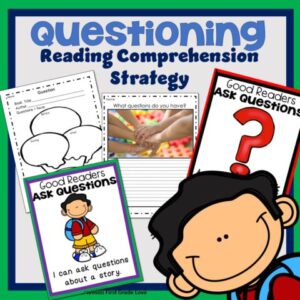Questioning Reading Comprehension Strategy is one of the 7 strategies taught for reading comprehension. To begin, you can teach what a question is, and how to use it in writing.

First, let me tell you a story! I was reading a book to my students. It was dead silent as the words fell from my mouth. I looked up to see the response of my students and saw all of my students looking at the book, staring with gaping mouths. When I set the book down in the middle of the story, they all said “Keep reading.” I said, “Well, that is all for today.” They all whined, “No keep reading.” At this point, I ask “What questions do you have?”
At that point, I had blank stares. They didn’t have any questions that they were aware of. However, they really had lots of questions. Otherwise, they wouldn’t want me to stop reading. I realized they are just not aware of the questions they in their heads already. And this is why we we as teachers have to teach them the questioning reading comprehension strategy and how to be aware of their own questions. They weren’t aware of their own questions, but had so many questions, actually. Here a some questions that were most like brewing in their little minds.

1. What will happen next?
2. Who did the main character see?
3. How will the story end?
4. Why did the main character do that?
5. When will the characters go to where they are going?
6. Where will they end up?
7. How will the story end?
8. Will it end well?
What is a question?
For really young students, Kindergarten and First Grade, you need to teach what a question is before you can dive into a strategy? You will need to modelthe questions. Explain that a question is something they need to supply an answer to, such as yes or no! this is also good time to teach the question mark that will go at the end of a question sentence.

To teach students, use examples they may have heard such as:
Are you going to clean your room?
Did you do your homework?
Will you go to bed?
Did you eat your supper?
Teaching Struggling Readers the Questioning Reading Comprehension Strategies
Struggling readers do not ask questions about the text as they read. So, teaching the questioning strategy will help increase reading comprehension. Also, questioning helps readers engage with the story, which will increase ability and reading comprehension.
Five Questions to Ask When Engaging Students in a Text
These are the W questions and can be used with younger students. To start, you can have students draw their hand and then write the five questions to begin the questioning process. Once they understand what a question is, you can delve deeper and use the other question words, too.

Who
What
When
Why
Where
Oops, there are actually more! These are just the W Questions.
In addition to the previous listed, I also teach these: How, Is, Did, Are? are a few more.
Questioning Before, During, and After Reading a Text
Once you have taught these things:
-what a question is,
-what are good question beginnings (Five W Question Words),
-how to write a question mark,
-when to put it at the end of a sentence,
Then you can teach questions students may have at the beginning, during, and after a text. This is a great way to teach the questioning reading comprehension strategy.
Use Literature to Teach Questioning Reading Comprehension Strategies
One of my favorite ways to teach any concept is through mentor texts! As students are listening to stories, they become engaged and invested in the story. Before, during, and after reading as story, you can teach how to question. Today, I will show an example of how to teach the questioning strategy with a mentor text.
I am going to use the mentor text, A Bad Case of Stripes. Many teachers own this book. If you don’t have this book, you can borrow from your public or school library. Another option is to have students watch it on YouTube at
Questions you Have Before Reading Mentor Texts
Before you get started reading this book, have students look at the front of the book, and formulate questions. They may ask why she have different colors on her face. They may also ask why does she have a thermometer in her mouth. In addition, they may have completely random questions. Write all these down on a table you have drawn on an anchor chart. At the top of the chart you can write Questions before, during, and after reading A Bad Case of Stripes.

Questions you Have During the Reading of the Mentor Text
As you read, pause in the middle and record questions students may have during the reading. I have recorded a few questions students may have in the middle.
- Why are the doctors giving her medicine?
2. Why is she changing colors?
3. Why is she changing shapes?
Questions you Have After Reading Mentor Texts
As you read and come to the end, you can pause again for questions or wondering students may still have after reading this text.
- Who was the old woman?
2. Why did she give her lima beans?
3. Why didn’t Camilla just eat what she likes?
4. Why did she worry about what people thought of her?
So, teaching students questioning can be another way to engage them, while reading a mentor text. A follow up printable or worksheet to write their questions as you read, or independently depending on their skill level. You can extend this activity in small group to have them ask questions before, during, and after reading another book independently.
Students that Use the Questioning Reading Comprehension Strategy to self check the understanding
When a student learns to investigate questions while reading monitor their comprehension independently, which increases self learning and comprehension. The ability to self-check their comprehension through questioning will increase comprehension.
So, are you looking for ways to help your kids with reading comprehension? This is a great tool to help you get started with young students who are just beginning to question. Are you an educator looking for new strategies to help students better understand what they read? Questioning is a great tool for reading comprehension as it helps students become actively engaged in their reading. This post explores the benefits of reading comprehension questioning strategy, provide tips for effective questioning, and discuss ways to keep students engaged.
Conclusion
Questioning is an effective reading comprehension strategy for students of all ages. It helps them become actively engaged in their reading, teaches them skills for furthering comprehension, and encourages critical thinking. By applying the tips outlined in this post, parents, educators, and students can use this strategy with confidence and success.
Now that you have a better understanding of the reading comprehension questioning strategy, try it out with your student, child, or class! Share your experience in the comments section below or on social media.
To try this out in your own classroom, click here for a ready to print resource to use with any text. Also, below is A Bad Case of Stripes Resources ready to print on the go! If you use either of these resources, please let me know how you were able to use them in your own classroom.


More Reading Comprehension
If you are interested in learning more about comprehension strategies, then you can follow these links.
